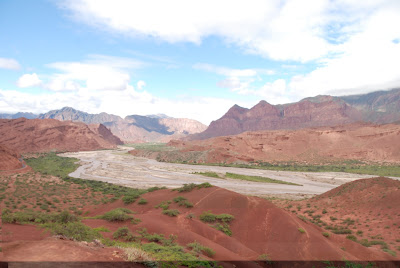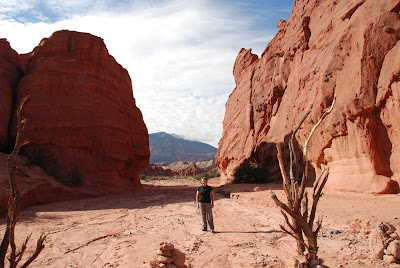I have spent the past 6 days in the northwestern provinces of Argentina--Salta, Tucaman, and Jujuy (pronounced Hoohooee). I decided to take a private tour rather than drive myself and I am sure glad I did! We covered 1400 km, with some long stretches over gravel roads and plenty of switch-back roads climbing up and down mountains. Even if I could have driven it safely I would not have seen a thing, since I'd never have been able to lift my eyes from the road. My guide, Joaquin, was a superb driver, completely fluent in idiomatic American English (although he has never been outside of northern Argentina), and full of information about the land, the geology, the culture, the flora and fauna and the people, which he imparted while cruising effortlessly round hairpin bends.
The contrasts between what I have seen in the north west and what I saw in the Cordoba area and in Buenos Aires are vivid--the people, the scenery, the terrain, the history, the colours. It is natural to want to relate new things one sees to places one knows, and the closest I can come up with is that the northwestern provinces of Argentina remind me of New Mexico and Arizona in the southwestern USA--the desert scrub, the deep rich pinks and reds of the rock, the native pueblos, the strange shapes of the rocks, the mountains, the gorges and canyons. However, although there are no jawdropping slits in the earth like the Grand Canyon, I think the colours and variety in the scenery are greater in Argentina .
Within a radius of about 200 kilometres from Salta, the main city, you can drink wine at a sophisticated vinyard in Cafayate, visit eery salt flats at Salinas Grandes on the way to the Andes and the Chilean border, drive up a mountain pass to 4700 meters with views to die for, view wierd shaped rocks formed by tectonic plate shifts and erosion, explore the ruins of native strongholds from Inca times at Quilmes and Pucara, visit charming little rural churches built of adobe in the 1700s and housing stunning rococo gold alters and fine paintings of the Cusco School (the Jesuits taught the Incas to paint in the European style and they were superb artists), drive through sub-tropical rainforest with moss and vines and orchids and then half an hour later through a desert of cactuses.
Take the cactus for example. The area is full of many -armed giants which you would immediately identify as suquaros, like those found in the the southwestern US and seen in many cowboy movies. But they are not. The Argentinian ones are cardones, and they are not even cousins of the suqauro. They have a wooden inner skeleton with holes in it as though a woodpecker had been at it. This is strong wood and all the pretty little seventeenth century churches have cactus wood ceilings and many have confessionals and altars of the wood as well. At the time it was the only wood available since there were no other trees of any size or substance except the hardy but scraggy acacia. Now there are a number of non-native species which have been introduced and which thrive, particularly in areas where man has introduced irrigation. Tall thin poplar trees or even cyprus are a sure sign of human habitation well before you see the little pale pink adobe house camouflaged against the pale pink rocks and soil and shaded by these foreign imports. In the river valleys shady willow trees and even oak trees flourish.
They say the dessert blooms when it receives water and that is certainly true in north western Argentina. The river valleys, areas which are irrigated, and the slopes beside mountain springs are filled with wonderful crops of carrots, pimentoes, cabbages, corn, lettuce, tomatoes, as well as cash crops like tobacco and soy beans and even sugar cane.
And that word "seventeenth century" in the previous paragraphs points to another difference between what you see in Argentina and what you would see in the southwestern US. North west Argentina has a longer and even more painful history than the southwestern USA, subject to continuous invasions from Peru and Bolivia during the Inca expansion and conquests of the 15th and early 16th century followed by the far more brutal and devastating scorched earth policies of the Spanish conquistadors and the somewhat more benign but no less disruptive expansion of the Jesuit missions, and finally it was a key battleground in the early nineteenth century when the south american colonies of Spain were fighting for their independence. The ruins of the native villages sit forlorn, many hardly excavated at all. But beside them are the new native villages of low adobe houses huddled together on narrow cobbled and dusty streets. And there are even modern ruins--the little railroad towns that were built in the nineteenth century and early twentieth century when Argentina was rich and expansionist, have been abandoned since the Argentinian government abandoned its railway system in the 1980s.
But the colours are what you really cannot believe. And you try again and again to capture them on film but they never look as good. Incongruously, the image that kept coming to my mind was Missoni designs, which I am very fond of. For those of you not familiar with the name, the Missoni family are Italian designers of beautiful and distinctive knitwear and fabrics with colourful zigzag patterns . That is what the colours and patterns of the mountains look like. Here is a link so you can see what I mean.
http://www.google.com.ar/search?q=missoni&hl=es-419&rls=com.microsoft:en-GB:%7Breferrer:source%3F%7D&rlz=1I7TSCA&prmd=imvns&tbm=isch&tbo=u&source=univ&sa=X&ei=H4poT5z9LYKutweZ99X8CA&ved=0CIwBELAE&biw=979&bih=422
How are these colours created? If you are a geologist and find the following explanation laughable, bear with me; I am inspired now to take a geology course so that I can really understand what I have seen. Northwestern Argentina was formed not by volcanic action but by tectonic plate shifts of its sedementary rock base. Thus you see mountains heaved up to show the strata vertically. You see fingers of erosion dribbling down the cliff faces looking like those sandcastles and mudpies you used to make as a child. The rock is very rich in iron, copper, lime and sulphates, which at various stages of oxidation yield brick reds, purples, pinks, forest greens, moss greens, spring greens, golds, yellows, creams, whites, with crytals adding a sparkle here and there.
And there are huge snow capped mountains--over 6000 metres. And salt flats shimmering like a mirage as far as the eye can see. And alpaca and llama and I even got a photo of the elusive and fleet of foot vicuna.
Yes, pictures. I took hundreds. I've included a selection here and will do some more in a few days (photo uploading is slow work). (Unfortunately my big Nikon is on strike and many of my photos do not do justice to the colours although my Canon S90 has filled the gap quite admirably.)
I also have more to say, particularly about the people and the towns and pueblos but will get this posted now and do another post with more pictures and the rest of the story, in a couple of days.
 |
| This is the view that greeted me on my first morning out of Salta. This is the hotel Payogasta and the snow covered mountains are over 6000 meters high. |
 |
| View along the way to Cachi |
 |
| The road winding through the mountains in the Quebrada (gorge) de Escoipe. Reaching to 3700 meters |
 |
| and again |
 |
| The viewpoint at the top of the road out of the Quebrada de Escoipe |
 |
| Los Cardones National Park |
 |
| Los Cardones National Park--the cardones are the cactuses. There is an arrow-straight Inca road that runs through the middle. |
 |
| ditto |
 |
| Arrow Gorge |
 |
| view from the road leading from Cafayate back to Salta |
 |
| One of the many spectacular coloured sights on the road from Cafayate |
 |
| And again |
 |
| Strange rock shapes in silhouette |
 |
| Llama grazing |
 |
| Needless to say the goats are quite at home on these mountains. And roast goat is delicious. |
 |
| Organ pipe-like cliffs |
 |
| a small village in the Quebrada de Humahuaca |
 |
| Quebrada de Humahuaca |
 |
| The Seven Coloured Hill behind the pueblo of Purmamarca |
 |
| A closer look |
 |
| some of the subtler greens of the copper oxide in the hills |
 |
| This one is nick-named the elephant's foot, and it must be a female elephant because of the painted toe-nails |
 |
| This is called the Painter's Palette, for obvious reasons. In the foreground are the mausoleums of the cemetery of the pueblo Tilcaara |
 |
| Ditto |
 |
| The quebrada (gorge) of Humahuaca |
 |
| the greens of the copper oxide in the mountain in the foreground, with the pinks of the iron oxide in the further range of mountains |
 |
| The road up from the Quebrada de Humahuaca over the Cuesta de Lipan pass to Salinas Grandes and then on across the Andes to Chile |
 |
| The highest point by road on the Cuesta de Lipan pass--4170 metres |
 |
| Mountain view in the Cuesta de Lipan pass |
 |
| ditto |
 |
| ditto |
 |
| The salt is raked into channels and pyramids to be harvested. |
 |
| The main highway crosses the salt flats. The walls of this service building is made entirely of blocks of solid salt |
 |
| The tropical rainforest on the cornice road from Salta to Jujuy. Note the orchids growing on the tree trunk and branches |
 |
| ditto |





No comments:
Post a Comment